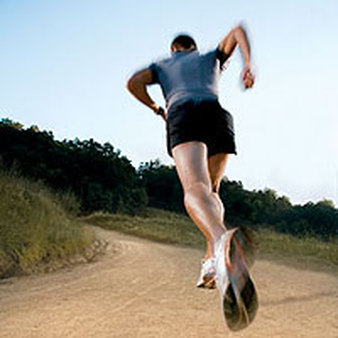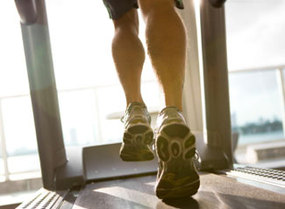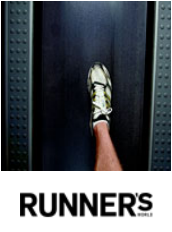 The Right Running Shoe FitGetting the proper fit is the most important factor when buying new running shoes. Here, four prominent specialty running-shoe store owners--each of whom has fitted thousands of runners--share some of their secrets.From the August 2004 issue of Runner's World 1. Line up the ball. "When you try your shoe on, the ball of your foot (the widest part) should line up exactly with the widest part of the shoe. If that fit is right, everything else should line up--from the toes to the heel. As for width, when you're standing in the shoe, your foot should rest gently against the sides of the shoe, rather than jamming up against them or not touching at all. Also, be sure your toes aren't being pinched from the side." -Chris Schmidt, The Finish Line, Allentown, Pennsylvania 2. Stand on one foot. "I have people stand on one foot, which puts extra stress on the shoe and the foot, so you can better tell if it's going to feel right. When standing, your foot should feel situated atop the midsole. That is, it shouldn't feel like it's moving around too much on top of the midsole, and it shouldn't feel like it's flopping over the sides of the midsole either. When you run in the shoe, don't be too put off if it feels overly supportive, as most runners need more support (or motion control) as they age." -Curt Munson, Playmakers, East Lansing, Michigan 3. Check for balance. "I have a runner stand in the shoes to see if he or she feels properly balanced. You should feel anchored; the shoes shouldn't be making you lean in a certain direction. There should be plenty of toe space, and when you walk or run, your heel shouldn't slide out of the shoe at all. I often have people run in the shoes down a slight hill next to the store. Downhill running exaggerates impact, so if the shoes feel okay, you should be fine in them." -Chet James, Super Jock 'n Jill, Seattle 4. Focus on the ride. "Once we determine the type of shoe you need--whether motion-control, stability, or another--we bring out shoes from three different manufacturers and have the customer try them all. Then you need to be sure there's no pinching, or a seam that's pressing against your foot. Finally, we have people run or walk in the shoe to really focus on the ride, or how the shoe feels from the point when the heel hits the ground to when the toe lifts off it." -Don Lucas, Luke's Locker, Dallas See More Articles in Running Shoe Basics
 So today I want to talk about my workout partner and lovely spouse Shannon. Shannon started in the gym about six months ago, and in the beginning her and I both were the story book weekend warriors who didn't reach many goals or even stay consistent for that matter. Well, we've been consistent now for two months and now starting to reap the rewards. Fitness isn't an easy task, cause if it was, well everyone would be in shape and looking great.
Shannon is plagued with having one leg slightly longer then the other, a cause of Scoliosis (from Greek: skoliōsis meaning from skolios, "crooked")[1] is a medical condition in which a person's spine is curved from side to side.
Having this condition has made being a runner very difficult and frankly a painful task. For the past 5 years Shannon has been under the watchful care of Dr. Ryan Nienaber of Boones Ferry Chiropractic and massage www.bfchiropractic.com Dr. Nienaber has been a great supporter of her overall health and fitness, and has reduced her spine curvature from 21% to 7%. Some might say this is a miracle, but the truth is that Dr. Nienaber is a doctor that seeks only to provide results by doing what most doctors and men for that matter don't do; and that's being a good listener.Shannon made a huge leap in her fitness today, a leap that makes me such a proud partner and spouse. If you could only of see the gleaming joy and pride she had in her smile today when she told me that she just ran non-stop for 3 miles. This might not be impressive to an elite athlete, but not more than a month ago Shannon couldn't even run a mile, and now she's both the Beauty and the Beast in the gym. Shannon, I must say you have been a great inspiration to me in the gym and in life. Your determination has been very influential in my consistent motivation and drive to seek better health for myself and our family. Thank You!I know it's hard to accomplish hellish gains and weigh loss in the gym when nagging pain is such a motivation killer. It's not easy and it's very frustrating, but with time the pain will hopefully subside and we all can live a healthier and more productive life for ourselves and family alike. I take pride in knowing that today was a milestone for Shannon and I both, the milestone that a lifestyle change has been accomplished. This is a point in our training that we both have sought for so long, and now we can stand tall and cherish the moment that were no long just weekend warriors, but on the path to being an overall athlete and hopefully along our path were able to motivate others to take on the same challenge.I want to say Thanks to Dr. Ryan Nienaber for all your loving support and to the staff of Boones Ferry Chiropractic and Massage for always greeting us with an enthusiastic smile. I also want to thank Ginny Gardea for being such a wonderful inspiration and needed motivator in and out of the gym. It's with having these supportive role models in our lives that we can feel that the world isn't such a horrible place and know that doing the right thing and paying it forward does pay off.

American Running Association
Explosive strength training has been recommended for competitive, elite runners for a long time. If you are a competitive runner, here's some research that might convince you to give it a try if you haven't already.
In a study at the Institute for Olympic Sports in Finland, researchers divided 18 elite, endurance athletes into two groups in which total training volume was the same for nine weeks. In one group, nearly a third of the training was replaced with explosive type strength training while the control group used only three percent of their training time for those techniques.
At the end of the nine-week period the experimental group who had trained with explosive strength exercises significantly improved their 5K times and 20-meter sprints as compared to controls, while their VO2max (a marker of aerobic potential) did not change.
The average runner, it must be remembered is not an elite, endurance runner such as those in the Finnish study. With that in mind, there is still much to be gained from an understanding of explosive strength training as long as you recognize that you must apply modifications and caveats carefully in order to avoid injury.
The caveat is that explosive strength training can be risky. The training techniques are very intense and your body should be well prepared with adequate strength and flexibility. You should have no sign of injury or pain, and you should begin any exercise with adequate warm up and stretching.
 Interval training is everywhere these days. If you haven’t heard of it or tried it yourself, you’re missing out big time! Perhaps you’ve done interval training without even knowing it – by taking a spin or other cardio-based exercise class, or maybe you incorporate sprints into your weekly jogs? Many of my clients tell me they are frustrated because their exercise routine is not producing the desired results of weight loss and improved fitness. Instantly I know that they are about to tell me they’re spending day after day doing the same monotonous routine – whether it is walking, biking, swimming, or pedaling away on the elliptical.
The answer is interval training. This type of program combines periods of high-energy bursts with periods of baseline/recovery work within one exercise session. During interval training the body shifts between aerobic and anaerobic exercise, and becomes more efficient at using lactic acid. Therefore, the body becomes able to exercise at higher levels for longer periods of time, improving your overall aerobic base and fitness level. Other benefits of interval training include: improved performance, endurance and speed; higher calorie burn; more interesting/less boring workouts; and shorter but more effective workouts. The great thing about interval training is that it can be incorporated into almost any workout, and people of all ages and fitness levels can do it. As you get more fit, just increase your levels to make it more challenging.
I have used interval training time and time again to help clients lose weight and improve their fitness base. You can do interval training for any type of aerobic exercise – outdoor walking or jogging, and gym equipment such as the treadmill, elliptical trainer, recumbent or stationary bike, stair climber, etc. Make sure to get clearance from your doctor if you have any cardiac risk factors or other health concerns.
So how do you get started? You should be able to get a “kick-butt” workout in 30 minutes or less. Start with a short warm-up and get right to it. Choose a level of work that feels relatively “easy” and stay there for 2 minutes. “Easy” should feel like a 3–4 on a scale of 1–10. Increase the level so the work feels “moderate” and continue for 2 minutes. This should feel like a 5–6 on that same scale of 1–10 and a level that you could maintain for 20–30 minutes. Next, raise the intensity again so it feels “challenging” and work there for another 2 minutes. “Challenging” feels like a 7–8 — you wouldn’t be able to maintain this workload for much longer than a few minutes. Step up the workload one final time to a level that feels like a 9–10 and will bring you to your anaerobic threshold or “breathless”. Stay there as long as you can – between 30 and 90 seconds. Once you have completed this cycle, immediately go back down to your “easy” level and start the cycle again. Repeat this cycle about four times and cool down.
Try it out TODAY! Let me know what you did and how it felt. Challenge yourself to try something or some level you’ve never tried before! I look forward to hearing from you. http://military-fitness.military.com/2011/02/get-quick-results-with-interval-training.html#more-2168
 By Coach Jenny Hadfield
For Active.com
Crossing the finish line of my first 5K changed my life forever. Drumming up the courage to start the race fueled a newfound confidence that led me to tackle other challenges.
Reaching the finish line ignited the start of a whole new active lifestyle.
Getting StartedI always wanted to run, but every time I tried to run I'd make it to the end of my block--only to start to cry because it wasn't much fun. Then I'd promptly drag myself back home and toss my shoes in the closet.
Each time I vowed to quit, never to return again, until I would see my softball coach, Rosemary, run by with a smile so bright it could light up Texas.
I wanted to run. I just couldn't figure out how and didn't think I had the body of a runner.
A Community of RunnersThat was, until I started my very first day at an internship in Milwaukee. All of my co-workers were runners, which I found quite intimidating as I couldn't even make it down my block without tears.
Runners being runners, they challenged me to run a 5K with them at the end of the summer. I promptly explained to them that I wasn't a runner and I would do almost anything (toilets, filing, laundry) for them, but there was no way I would be running that race.
What happened next turned out to be a pivotal moment in my life.
 6 Tips to Expand Your Training Schedule By Marc Bloom Runner's World Long runs, tempo runs, speed-work, hill repeats. You know these are the quality workouts that will propel you to your goals. The trouble is, how do you fit them all in every week, and still have ample time to recover fully after each hard effort? One simple solution: don't. Instead of trying to stuff your hard days between Monday and Sunday, spread your most important sessions over a 10- to 28-day period, or training cycle. On the other days, run easy, cross-train, or simply take a day off. "You can't do all the different types of workouts, and hit all the energy systems, in seven days," says Greg McMillan, an exercise physiologist and coach in Flagstaff, Arizona. "But in a cycle of, say, 14 or 21 days, you can cover more territory and become a more well-rounded runner prepared for a variety of racing distances." Professional and collegiate coaches have long used cycle training with their elite athletes. Marathoners like Deena Kastor and Meb Keflezighi use longer training cycles to hit different energy systems multiple times, says Andrew Kastor, head coach of the High Sierra Striders. But the approach benefits anyone who can use extra recovery time so they're fresh for hard efforts, including beginners, the injury-prone, and masters runners. Plus, an expansive cycle allows for more wiggle room—if you have to reschedule a key workout, it won't throw off your whole routine the way it might in a weekly plan. That said, most of us live by the seven-day-a-week calendar, so it does take some planning to train in cycles. Whether you've got a race goal or are just looking for a fresh training strategy, here's how to make it work for you. Choose the Length Runners aiming for 5Ks and 10Ks can use a 10-, 14-, or 21-day cycle, says McMillan. If you're planning to do a half or full marathon, a 21- or 28-day cycle works best as it allows more time for recovery. In general, if you like a lot of structure, stick to shorter cycles of 10 to 14 days. If you prefer more flexibility, opt for the longer ones. Plan Ahead Targeting a goal race? Determine how many cycles you'll need by counting back from race day. You'll need at least eight weeks to train for a 5K or a 10K, which works out to about six 10-day cycles or three 21-day cycles. Half-marathoners need 10 weeks to build up, or three to four 21-day cycles; full marathoners need 16 weeks, or four 28-day cycles. Pick a Number How many quality workouts you do during your cycle depends on your experience level and injury history, says Kastor. More seasoned runners can usually handle more frequent tough sessions. "After training for several years, our body recovers more efficiently, and we can run hard more often," he says. Kastor recommends that beginners who run fewer than 15 miles per week do three or four hard workouts during a 10-day cycle, five or six over a 14-day cycle, and eight or nine over a 21-day cycle. Intermediate to advanced runners running 30 to 40 miles or more per week can schedule four during a 10-day cycle, six over a 14- day cycle, nine over a 21-day cycle, and 12 over a 28-day cycle, says Kastor. Mix Them Up Key workouts should include long runs, race-simulation or tempo runs, and speedwork that includes long and short intervals, says McMillan. Plot Them Out Schedule your quality sessions in any order across your cycle. But start your cycle with your long run to make sure your most time-consuming workouts don't land inconveniently midweek—on, say, a Wednesday when you have to go to work early and drive your kids to after-school soccer practice. And never run two hard days in a row. Schedule Rest Run easy or cross-train before and after tough workouts, giving yourself extra easy days before and after your most tiring sessions. Mixing in cross-training will build overall fitness and make you that much more rested and prepared for your hard efforts. Every six days or so, take a well-earned day of total rest. http://www.active.com/running/Articles/6-Tips-to-Expand-Your-Training-Schedule.htm?cmp=17-7-254
|






 RSS Feed
RSS Feed







